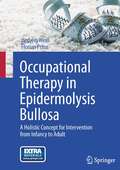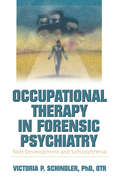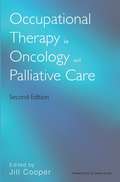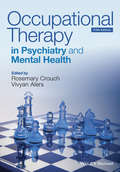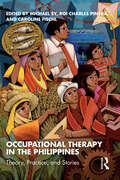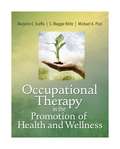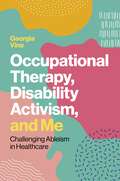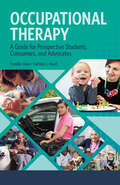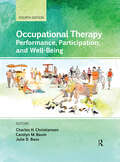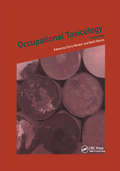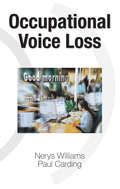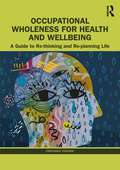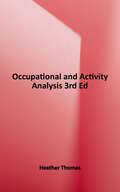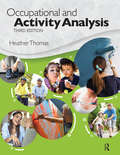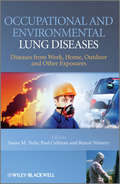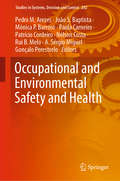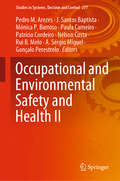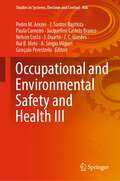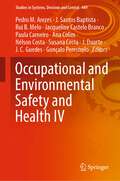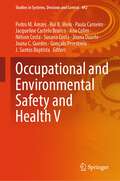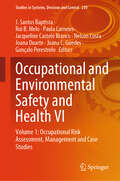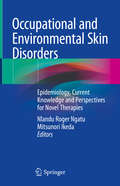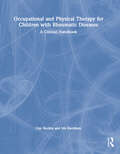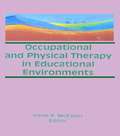- Table View
- List View
Occupational Therapy in Epidermolysis bullosa
by Florian Prinz Hedwig WeißEpidermolysis bullosa (EB) is the collective term for a heterogenous group of genetic skin disorders characterised by the formation of blisters and erosions on skin and mucous membranes. This book deals with early childhood motor and perceptual development, a particular challenge for children with extremely fragile skin. Going into functional treatment, it addresses rehabilitation of hands and feet in EB patients with fusions or contractures. The authors are occupational therapists with long-term experience in the management of EB patients. In an extraordinary holistic approach, they present a combination of paediatric and functional areas of treatment. Occupational therapy tools and interventions can help alleviate a number of accompanying complications and symptoms of EB, enhance self-care, and improve quality of life in general. Due to its practical approach, this book not only serves as a unique guide for doctors and health care professionals but is also comprehensible and useful for patients.
Occupational Therapy in Forensic Psychiatry: Role Development and Schizophrenia
by Victoria P SchindlerLearn Role Development techniques to provide more effective therapy to schizophrenic clients!Occupational Therapy in Forensic Psychiatry: Role Development and Schizophrenia presents a set of guidelines for clinical practice in Role Development. Role Development is a treatment intervention designed to assist individuals diagnosed with schizophrenia in developing social roles, task skills, and interpersonal skills. The book provides concrete, practical suggestions for using Role Develpoment with clients. These guidelines are thoroughly described as are methods for implementing treatment. With the resources provided in Occupational Therapy in Forensic Psychiatry, OT clinicians will have the tools and information to understand Role Development, to conduct evaluations, and to plan and implement treatment using the set of guidelines. The book describes a reseach study from a maximum-security psychiatric facility. Participants in the study had an extensive psychiatric history as well as criminal charges. Most no longer had active social roles but viewed their roles as patient or inmate. The intervention, Role Development, was successful in assisting them to develop roles such as worker, student, friend, and group member. Despite their very difficult life circumstances and serious mental illness, the participants responded very positively and demonstrated a willingness and ability to develop social roles, and the skills that are the foundation to the roles. Tables and figures highlight the results of the study. In Occupational Therapy in Forensic Psychiatry, you&’ll find: a set of guidelines for practicing Role Development a research study documenting the effectiveness of Role Development tables and figures highlighting the results of the research study practical tools, resources, and methods to implement Role Development case studies demonstrating the application of Role Development and much more!Occupational Therapy in Forensic Psychiatry is a comprehensive resource for OT clinicians and students. It provides the direction needed for health care practitioners to learn Role Development techniques. Clinicians who work with clients diagnosed with schizophrenia or other forms of severe and persistent mental illness can use the information in this book to provide effective treatment to their clients.
Occupational Therapy in Oncology and Palliative Care
by Jill CooperNow in its second edition, this is the only book on occupational therapy in oncology and palliative care. It has been thoroughly updated, contains new chapters, and like the first edition will appeal to a range of allied health professionals working with patients with a life-threatening illness.The book explores the nature of cancer and challenges faced by occupational therapists in oncology and palliative care. It discusses the range of occupational therapy intervention in symptom control, anxiety management and relaxation, and the management of breathlessness and fatigue.The book is produced in an evidence-based, practical, workbook format with case studies. New chapters on creativity as a psychodynamic approach; outcome measures in occupational therapy in oncology and palliative care; HIV-related cancers and palliative care.
Occupational Therapy in Orthopaedics and Trauma
by Madeleine Mooney Claire IresonThis book fills a gap in providing specialist information on orthopaedics and trauma occupational therapy.<P><P> Its contributors bring together information on the aetiology, surgical input and the occupational therapy intervention appropriate to this client group. It is divided into two main sections, the first being orthopaedics and the second orthopaedic trauma. The first part is further subdivided to cover lower limb surgery, upper limb surgery, spinal conditions, and paediatric orthopaedic conditions. In Part two, principles of fracture management are covered, followed by pelvic and acetabular reconstruction, hand injuries and traumatic amputation.
Occupational Therapy in Psychiatry and Mental Health
by Vivyan Alers Rosemary CrouchComprehensive and informative, the extensively revised fifth edition of Occupational Therapy in Psychiatry and Mental Health is an accessible overview of occupational therapy in psychiatry, providing key information on a range of international models of occupational therapy as well as their practical applications. The fifth edition includes: * Case studies throughout to illustrate application of theory to practice * Coverage of key concepts and issues in occupational therapy * New material on emerging areas of practice * Comprehensive information on assessment and treatment for children, adolescents and adults, covering key mental health conditions Occupational Therapy in Psychiatry and Mental Health is an ideal resource for students in occupational therapy, newly qualified and experienced practitioners, and other allied health professionals seeking an up-to-date, globally relevant resource on psychiatry and mental health care.
Occupational Therapy in the Philippines: Theory, Practice, and Stories
by Michael SyThe first book of its kind, Occupational Therapy in the Philippines provides a context to the existing occupational therapy knowledge base from a Filipino perspective. This book acts as a guide for occupational therapists to develop and continually evaluate trusting working relationships with clients and other health and social care professionals, leading to more effective occupational therapy services. It discusses occupational therapy concepts, principles, and practices and illustrates examples of occupational therapy practices based on Filipino case studies, narratives, and evidence, and offers recommendations on how to enrich occupational therapy understanding globally. The chapters delve into theory, education and training, clinical practice, research, case studies and topical issues. This book is an ideal read for occupational therapy students and practitioners from all areas of practice as well as to those who are interested to know more about occupational therapy.
Occupational Therapy in the Promotion of Health and Wellness
by Marjorie E. Scaffa S. Maggie Reitz Michael A. PizziThis book teaches students about health promotion and prevention theory and practice from a wellness rather than an illness perspective. Using "cutting edge" examples, the authors explore how to incorporate this new paradigm into clinical practice and how to develop wellness interventions across the lifespan.
Occupational Therapy, Disability Activism, and Me: Challenging Ableism in Healthcare
by Georgia VineHow can health and social care services better serve people with disabilities? How can we meaningfully challenge ableist practice? What would a truly inclusive system look like?Georgia Vine answers these questions and more as she charts her journey from her experience of children's services to occupational therapist and disability activist. Discussing stigma, independence, and the transition to adulthood, Georgia provides vital insight into the challenges she has faced and the communities she has built along the way.Each chapter includes a reflection log enabling health and social care workers to think critically and practically about what they've learnt and how best to apply it to their role.
Occupational Therapy: A Guide for Prospective Students, Consumers, and Advocates
by Franklin Stein Kathlyn ReedA helpful resource that explains occupational therapy for students, clients, families, school counselors, and health professionals, Occupational Therapy: A Guide for Prospective Students, Consumers, and Advocates provides an understanding of what occupational therapists do to help people function in everyday activities. Written by esteemed authors Drs. Franklin Stein and Kathlyn L. Reed, Occupational Therapy: A Guide for Prospective Students, Consumers, and Advocates explains one of the fastest growing professions in the world. Featuring information on the specific interventions used in daily work, the educational requirements for becoming an occupational therapist, and the clinical settings where occupational therapists work, this book is the perfect introduction to the profession. Chapters are designed to educate prospective students about occupational therapy as well as the personal qualities needed to be an effective clinician. Detailed information is included with up-to-date facts great for sharing with those interested in this career. A glossary of terms at the conclusion assists students, consumers, and advocates who want to better understand the profession. Topics include: What is occupational therapy? Comparing occupational therapy to similar health professions What is the history of occupational therapy? Personal characteristics of occupational therapists Professional codes of ethics Occupational therapy clients The perfect companion book for any aspiring student or interested health professional, Occupational Therapy: A Guide for Prospective Students, Consumers, and Advocates is a great resource for all things occupational therapy.
Occupational Therapy: Performance, Participation, and Well-Being
by Charles H. Christiansen Julie Bass Carolyn M. BaumOccupational Therapy: Performance, Participation, and Well-Being, Fourth Edition, is a comprehensive occupational therapy text that introduces students to core knowledge in the profession and the foundations of practice—the occupations, person factors, and environment factors that support performance, participation, and well-being. Editors, Drs. Charles H. Christiansen, Carolyn M. Baum, and Julie D. Bass, are joined by more than 40 international scholars who bring students, faculty, and practitioners the evidence that supports occupational therapy practice. The PEOP Model 4th Edition is featured as an exemplar of a person-environment-occupation model and provides a valuable roadmap for understanding key concepts and developing strong clinical reasoning skills in the occupational therapy process. Features: Examines the theories, models, frameworks, and classifications that support contemporary knowledge of person, environment, and occupational factors. Presents detailed chapters on the occupations of children and youth, adults, older adults, organizations, and populations Provides extensive coverage of the person factors (psychological, cognition, sensory, motor, physiological, spirituality) and environment factors (culture, social, physical, policy, technology) that support occupational performance Includes exceptional content on the essentials of professional practice - therapeutic use of self, evidence-based practice, professionalism, lifelong development, ethics, business fundamentals, and critical concepts Builds clear links with the AOTA’s Occupational Therapy Practice Framework, Third Edition; International Classification of Functioning, Disability and Health, and accreditation standards for entry-level occupational therapy programs. Introduces emerging practice areas of self-management, community-based practice, technology, and teaching/learning and opportunities to work with organizations and populations Incorporates international and global perspectives on core knowledge and occupational therapy practice. Documents assessments, interventions, resources, and evidence in user-friendly tables Uses simple and complex cases to illustrate key concepts and ideas. New and Updated Sections in the Fourth Edition: Individual chapters on each person factor and environmental factor and occupations across the lifespan Expanded coverage of approaches for organizations and populations and entry-level professional skills Consistent framework of tables and language across chapters and sections. Included with the text are online supplemental materials for faculty use in the classroom including PowerPoint presentations.
Occupational Toxicology
by Chris Winder Neill StaceyHazardous agents are an ongoing concern in the modern workplace, with many examples of workers being severely affected by chemicals as a result of both acute and chronic exposure. Occupational Toxicology, 2nd Edition introduces the basics of toxicology that underpin the application of toxicological information to the workplace environment.
Occupational Voice Loss
by Nerys Williams Paul CardingThe first guide to cover aspects of voice loss from an occupational health perspective, this reference covers procedures to detect, assess, and prevent voice loss in schools, industrial facilities, and other workplace environments, as well as covers occupational groups at risk and risk factors for developing voice loss-analyzing various chemical, e
Occupational Wholeness for Health and Wellbeing: A Guide to Re-thinking and Re-planning Life
by Farzaneh YazdaniThis practical book introduces a new, research-based model of occupational wholeness, a way of conceptualising satisfaction with what one does to meet needs for being, belonging and becoming. It explores how to: conceptualise people's life stories through the model; take vital steps to help identify any problems; draw personal profiles; introduce intervention strategies for promoting wellbeing. Focusing on enhancing wellbeing, rather than ill health, the concept of occupational wholeness supports people to feel more control of their own lives and helps to identify what balance can be created, while recognising personal limitations and environmental restrictions. Alongside theoretical background, it includes practice applications and practical tools, with scenarios and activities to consolidate learning. Providing a unique combination of the practice and theory of occupational science, Yazdani integrates occupational science, psychology and sociology with clinical experience of working with diverse groups of people in different countries. This book is an important guide and reference for occupational therapists, occupational scientists, counsellors and life coaches.
Occupational and Activity Analysis
by Heather ThomasNewly updated to reflect the Occupational Therapy Practice Framework: Domain and Process, Fourth Edition (OTPF-4), Occupational and Activity Analysis, Third Edition outlines the process of conducting occupational and activity analyses for occupational therapy students and clinicians. <p><p>Occupational therapy practitioners use occupations and activities not only as a goal but also as a treatment medium, so understanding both the uniqueness of a client's occupation and how an activity can be used therapeutically is essential. This text is an introduction to both realms, first by explaining the process by which to peel back the layers of an occupation or activity to reveal its intricacy and then examining how to use this information for evaluation and intervention. <p><p>Dr. Heather Thomas has updated Occupational and Activity Analysis, Third Edition to reflect the significant changes made to the activity analysis process and terminology in the OTPF-4. Conducting either an occupational or activity analysis investigates not only what is required for full participation but also looks at the meaning ascribed to it by the people, groups, or communities engaging in it and how personal and environmental contexts impact participation. <p><p> What's new and included in the Third Edition: <p>• Chapters throughout the text have been updated to reflect the changes in the OTPF-4. <p>• Updated educational standards set by the Accreditation Council for Occupational Therapy Education (ACOTE) for doctoral and master's level and occupational therapy assistant programs. <p>• Additional cases and relevant clinical examples. <p>• Updated tables, boxes, and figures throughout. <p>• Expanded section on communication management. <p>• Appendices containing updated occupational and activity analysis forms. <p>• Example of a full activity analysis. <p>• Updated and added photos to help students understand concepts. <p>• Instructors in educational settings can visit www.efacultylounge.com for forms, videos, and PowerPoint presentations to be used for teaching in the classroom. <p><p>As a foundational skill, occupational and activity analysis is utilized throughout students' careers and into their lives as practitioners, making Occupational and Activity Analysis, Third Edition the perfect textbook for the occupational therapy or occupational therapy assistant student, faculty, or clinician.
Occupational and Activity Analysis
by Heather ThomasNewly updated to reflect the Occupational Therapy Practice Framework: Domain and Process, Fourth Edition (OTPF-4), Occupational and Activity Analysis, Third Edition outlines the process of conducting occupational and activity analyses for occupational therapy students and clinicians.Occupational therapy practitioners use occupations and activities not only as a goal but also as a treatment medium, so understanding both the uniqueness of a client’s occupations and how an activity can be used therapeutically is essential. This text is an introduction to both realms, first by explaining the process by which to peel back the layers of an occupation or activity to reveal its intricacy and then examining how to use this information for evaluation and intervention.Dr. Heather Thomas has updated Occupational and Activity Analysis, Third Edition to reflect the significant changes made to the activity analysis process and terminology in the OTPF-4. Conducting either an occupational or activity analysis investigates not only what is required for full participation but also looks at the meaning ascribed to it by the people, groups, or communities engaging in it and how personal and environmental contexts impact participation.What’s new and included in the Third Edition: Chapters throughout the text have been updated to reflect the changes in the OTPF-4. Updated educational standards set by the Accreditation Council for Occupational Therapy Education (ACOTE) for doctoral and master’s level and occupational therapy assistant programs. Additional cases and relevant clinical examples. Updated tables, boxes, and figures throughout. Expanded section on communication management. Appendices containing updated occupational and activity analysis forms. Example of a full activity analysis. Updated and added photos to help students understand concepts. Included with the text are online supplemental materials for faculty use in the classroom.As a foundational skill, occupational and activity analysis is utilized throughout students’ careers and into their lives as practitioners, making Occupational and Activity Analysis, Third Edition the perfect textbook for the occupational therapy or occupational therapy assistant student, faculty, or clinician.
Occupational and Environmental Lung Diseases
by Benoit Nemery Paul Cullinan Susan TarloDocuments both environmental and work-related causes of lung diseaseUnlike other books on the subject, this new volume approaches occupational and environmental lung disease from the starting point of the patient who comes to the physician with respiratory symptoms. The authors recognize that potentially harmful exposures occur not only in the work environment, but also as a result of hobbies or other leisure activities, or from outdoor air pollution, and it is up the physician to identify whether a particular job or hobby is the cause of the patient's respiratory symptoms.To help you arrive at a differential diagnosis, chapters in the book are arranged by job or exposure, and are divided into 5 sections:Personal environmentHome environmentOther indoor environmentsWork environmentGeneral environmentEach is written by an expert in the specific topic and provides pragmatic information for the practicing physician. This practical book is an invaluable resource that belongs close at hand for all physicians dealing with patients experiencing respiratory symptoms.
Occupational and Environmental Safety and Health (Studies in Systems, Decision and Control #202)
by Pedro M. Arezes Paula Carneiro Patrício Cordeiro Rui B. Melo Gonçalo Perestrelo João S. Baptista Mónica P. Barroso Nélson Costa A. Sérgio MiguelThis book explores a number of important issues in the area of occupational safety and hygiene. Presenting both research and best practices for the evaluation of occupational risk, safety and health in various types of industry, it particularly focuses on occupational safety in automated environments, innovative management systems and occupational safety in a global context. The different chapters examine the perspectives of all those involved, such as managers, workers and OSH professionals. Based on selected contributions presented at the 15th International Symposium on Occupational Safety and Hygiene (SHO 2019), held on 15–16 April, 2019, in Guimarães, Portugal, the book serves as a timely reference guide and source of inspiration to OSH researchers, practitioners and organizations operating in a global context.
Occupational and Environmental Safety and Health II (Studies in Systems, Decision and Control #277)
by Pedro M. Arezes Paula Carneiro Patrício Cordeiro Rui B. Melo Gonçalo Perestrelo Mónica P. Barroso Nélson Costa A. Sérgio Miguel J. Santos BaptistaThis book explores a number of important issues in the area of occupational safety and hygiene. Presenting both research and best practices for the evaluation of occupational risk, safety and health in various types of industry, it particularly focuses on occupational safety in automated environments, innovative management systems and occupational safety in a global context. The different chapters examine the perspectives of all those involved, such as managers, workers and OSH professionals. Based on selected contributions presented at the 16th International Symposium on Occupational Safety and Hygiene (SHO 2020), held on 6–7 April, 2020, in Porto, Portugal, the book serves as a timely reference guide and source of inspiration to OSH researchers, practitioners and organizations operating in a global context.
Occupational and Environmental Safety and Health III (Studies in Systems, Decision and Control #406)
by Pedro M. Arezes Paula Carneiro Rui B. Melo Gonçalo Perestrelo Nélson Costa A. Sérgio Miguel J. Duarte J. Santos Baptista Jacqueline Castelo Branco J. C. GuedesThis book gathers cutting-edge research and best practices relating to occupational risk and safety management, healthcare and ergonomics. It covers strategies for different types of industry, such as construction, food, chemical and healthcare. It gives a special emphasis on challenges posed by automation, discussing solutions offered by technologies, and reporting on case studies carried out in different countries. Chapters are based on selected contributions to the 17th International Symposium on Occupational Safety and Hygiene (SHO 2021), held virtually on November 17–19, 2021, from Portugal. By reporting on different perspectives, such as the ones from managers, workers and OSH professionals, and covering timely issues, such as safety evaluation of human-robot collaboration, this book offers extensive information and a source of inspiration to OSH researchers, practitioners and organizations operating in both local and global contexts.
Occupational and Environmental Safety and Health IV (Studies in Systems, Decision and Control #449)
by Pedro M. Arezes Paula Carneiro Rui B. Melo Gonçalo Perestrelo Nélson Costa J. Duarte J. Santos Baptista Jacqueline Castelo Branco J. C. Guedes Ana Colim Susana CostaThis book gathers cutting-edge research and best practices relating to occupational risk and safety management, healthcare and ergonomics. It covers strategies for different industries, such as construction, chemical and healthcare. It emphasises challenges posed by automation, discusses solutions offered by technologies, and reports on case studies carried out in different countries. Chapters are based on selected contributions to the 18th International Symposium on Occupational Safety and Hygiene (SHO 2022), held on September 8–9, 2022, in Porto, Portugal. By reporting on different perspectives, such as the ones from managers, workers and OSH professionals, and covering timely issues, such as implications of telework ,issues related to gender inequality and applications of machine learning techniques in occupational health, this book offers extensive information and a source of inspiration to OSH researchers, practitioners and organizations operating in both local and global contexts.
Occupational and Environmental Safety and Health V (Studies in Systems, Decision and Control #492)
by Pedro M. Arezes Paula Carneiro Rui B. Melo Gonçalo Perestrelo Nélson Costa J. Santos Baptista Joana Duarte Jacqueline Castelo Branco Ana Colim Susana Costa Joana C. GuedesThis book gathers cutting-edge research and best practices relating to occupational risk and safety management, healthcare, and ergonomics. It covers strategies for different industries, such as construction, chemical and healthcare. It emphasizes challenges posed by automation, discusses solutions offered by technologies, and reports on case studies carried out in different countries. Chapters are based on selected contributions to the 20th International Symposium on Occupational Safety and Hygiene (SHO 2023), held on July 20-21, 2023, in Portugal, as a hybrid event. By reporting on different perspectives, such as the ones from managers, employees, and OSH professionals, and covering timely issues, such as implications of telework, issues related to gender inequality and applications of machine learning techniques in occupational health, this book offers extensive information and a source of inspiration to OSH researchers, practitioners and organizations operating in both local and global contexts.
Occupational and Environmental Safety and Health VI: Volume 1: Occupational Risk Assessment, Management and Case Studies (Studies in Systems, Decision and Control #230)
by Paula Carneiro Nelson Costa Rui B. Melo Gonçalo Perestrelo J. Santos Baptista Joana Duarte Jacqueline Castelo Branco Joana C. GuedesThis book gathers cutting-edge research and best practices relating to occupational risk and safety management, healthcare, and ergonomics. It covers strategies for different industries, such as construction, chemical, and healthcare. It emphasizes challenges posed by automation, discusses solutions offered by technologies, and reports on case studies carried out in different countries. Chapters are based on selected contributions to the 21st International Symposium on Occupational Safety and Hygiene (SHO 2024), held on July 4-5, 2024, in Porto, Portugal. By reporting on different perspectives, such as the ones from managers, employees, and OSH professionals, and covering timely issues, such as implications of telework, issues related to gender inequality and applications of machine learning techniques in occupational health, this book offers extensive information and a source of inspiration to OSH researchers, practitioners, and organizations operating in both local and global contexts. This is the first volume of a 2-volume set.
Occupational and Environmental Skin Disorders: Epidemiology, Current Knowledge and Perspectives for Novel Therapies
by Nlandu Roger Ngatu Mitsunori IkedaThis book provides cutting-edge information on the epidemiology, etiology and pathophysiology of several prevalent occupational and environmental skin diseases (OSD/ESD), with a particular focus on skin health safety issues, risk factors, preventive measures and recent advances in the management of these diseases. It also highlights recent discoveries and developments concerning novel therapeutic agents for inflammatory OSD, especially findings that are supported by clinical data and have the potential to transform conventional prophylactic and therapeutic approaches. For example, despite their increasing prevalence, the management of allergic skin diseases is sometimes challenging, mainly due to limited treatment choices. In several countries, steroids are the only treatment used. However, in cases of contraindications, adverse effects or unsatisfactory steroidal therapies, alternative treatments are indispensable. As such, an understanding of promising anti-allergic agents enhances allergy research and could eventually lead to novel alternative therapeutic and adjuvant remedies, which are of the utmost importance. This book offers a valuable resource for researchers, graduate students and practitioners in the field of public health in general, especially those working in environmental and occupational medicine, as well as physicians.
Occupational and Physical Therapy for Children with Rheumatic Diseases: A Clinical Handbook
by Gay Kuchta Iris Davidson Surrey Patel'This volume comes at an important time in the development of the discipline, and reflects the knowledge gained by the authors through decades of hands-on experience of treating children and adolescents with the entire spectrum of rheumatic diseases. It emphasizes the integration of the expertise of all health care providers in an interactive team' - Ross Petty in the Foreword. This highly practical handbook is easy to read and refer to on a daily basis. The wide-ranging style encourages a multidisciplinary, team-based approach to provide continuity of care, and the handy binding and layout is designed to aid quick access of core information. Featuring over 230 full-colour images and reproducible resources for patients and carers, this guide is a vital resource for Allied Health Professionals, especially those working with children.
Occupational and Physical Therapy in Educational Environments
by Irene McewenOccupational and Physical Therapy in Educational Environments covers the major issues involved in providing lawful, team-oriented, and effective occupational and physical therapy services for students with disabilities in public schools. For those involved with students with disabilities, this book helps them make sound decisions about services that will make a meaningful difference in the lives of these children.Since the 1975 enactment of Public Law 94--142, which mandated that occupational and physical therapy be provided “as may be required by a handicapped child to benefit from special education,” this required link between therapy and education has continued to lead to confusion and controversy about which students should receive therapy in school and what types of services should be provided. The purpose of Occupational and Physical Therapy in Educational Environments is to clarify the major issues surrounding occupational and physical therapy in public schools, and to provide a framework for delivery of team- and family-oriented services that meet individual needs of students with disabilities.For those unsure of current regulations regarding handicapped students, or those who need clarification on the law, the book begins with a review of legislation and regulations. This begins to guide and shape schools’provision of therapy services. The following chapters assist occupational and physical therapists and important members of the educational teams of disabled students to make sound decisions about which students need school-based therapy services: Laws that Shape Therapy Services in Educational Environments: summarizes the major statutory law, federal regulations, and case law interpretation in which school-based practice is grounded. Pediatric Therapy in the 1990s: reviews contemporary theories of motor development, motor control, and motor learning that have had major impact on therapy for school-age children with disabilities. Related Services Decision-Making: describes a strong team approach to determining a student’s need for occupational and physical therapy services, which takes into account the unique characteristics of both the student and the educational team. Assessment and Intervention in School-Based Practice: describes an approach to assessment and intervention in schools that clearly illustrates a relationship between therapy and educational programs that result in meaningful outcomes for students. Challenges of Interagency Collaboration: reports on a qualitative study that points out that schools are not the only settings in which many students with disabilities receive services, so coordination between various agencies is essential to avoid gaps, overlaps, and cross purposes.Those who can benefit from Occupational and Physical Therapy in Educational Environments include occupational and physical therapists who work in public schools, school administrators, teachers, and even parents of disabled children.
